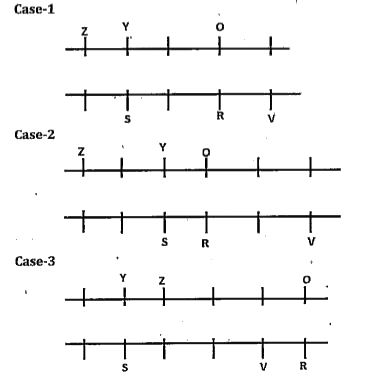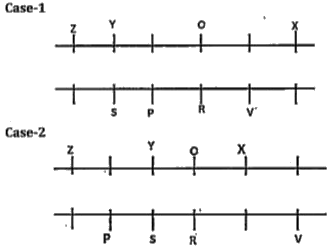Study the following information to . answer the given question.
Twelve people are sitting in two parallel rows containing six people each, in such a way that there is an equal distance between adjacent persons. In row-1 M, N, O, Z, X and Y are seated and all of them are facing south. In row-2 P, Q, R, S, T and V are seated and all of them are facing north. Therefore, in the given seating arrangement each member seated in a row faces another member of the other row. Also any row's six members are related to each other in a family tree of three generation. There are two married couple in the family.
V sits third to right of S. S faces Z's sister and Z's sister does not sit at any of the extreme ends of the line. Z, who is the grandson of O, sits third to right of O. R faces M's wife. The one facing N's husband sits third to right of P. N and P do not sit at the extreme ends of the line. M is the father-in law of X. T is not an immediate neighbour of V and N's father is not an immediate neighbor of O, who has only one child who is a girl.
Who amongst the following represent the people sitting at extreme ends of the rows?
RY
TM
ZR
OQ
The correct Answer is:B
From the given conditions, first we try to complete blood relation tree from some given points.
Points are like as, Z.s sister, Z, who is the grandson of O. M.s wife, N.s husband. M is the father-in-law of X. N.s father. O, who has only one daughter. From those points we deduce the following blood relation tree.

From the other conditions we try to complete linear arrangement. V sits third to right of S. S faces Z.s sister and Z.s sister does not sit at any of the extreme ends of the line. R faces M.s wife. Hence R faces O. Z sits third right of O. Hence there are three possibilities for the position of O.

From the conditions, the one facing N.s husband sits third to right of P. N and P do not sit at the extreme ends of the line. So case-3 is eliminated. Case-1 and Case-2 is continued.

From the rest conditions, T is not an immediate neighbour of V and N.s father is not an immediate neighbor of O. Hence M is not immediate neighbour of O, so case-1 is eliminated. Case-2 is continued. N does not sit extreme end of the row, so final arrangement are

Similar Questions
एक कक्षा के छात्रों को पंक्ति में खड़ा किया जाता है। यदि प्रत्येक पंक्ति में 4 अतिरिक्त छात्र होते तो 2 पंक्ति कम प्रत्येक पंक्ति में 4 छात्र कम होते तो 4 पंव्ति ज्यादा होती है। कक्षा में छात्रों की संख्या ज्ञात कीजिए।
View Solutionएक के विद्यार्थियों क्रो पंकितियों में खड़ा होना है। यदि पक्ति में 3 विधर्थी अधिक होते, तो 1 पक्ति कम होती । यदि पक्ति में 3 विधार्थी कम होने , तो 2 पंक्तिया अधिक बतनी ।कक्षा में विद्यार्थियों की संख्या ज्ञात कीजिए।
View Solutionसमान चालकता सेल में लिए गए दो विलयनों A तथा B के प्रतिरोध क्रमशः 50 ओम तथा 100 ओम है । यदि A व B के सामान आयतन मिला दिए जाये तो सामान चालकता सेल में मिश्रण का प्रतिरोध क्या होगा ?
(मोल A व B को मिलाने पर वियोजन की मात्रा में कोई परिवर्तन नहीं होता है)
View Solutionयदि A और B दो घटनाएँ इस तरह से हों कि P(A)=13,P(B)=14,P(A∩B)=15 तो P(A/B)=
View Solutionनिम्नलिखित कथनों पर विचार करें :
कथन I : यदि A और B प्रतिदर्श समष्टि S के संगत दो घटनाएँ ऐसा है कि P(A)=0.2 और P((B)=0⋅8 तो A⋃B एक सुनिश्चित घटना है |
कथन I : यदि A और B परस्पर अपवर्ती हों तो P(A)+P(B)=1 इन कथनो में :
View Solutionयदि A तथा B दो स्वतंत्र घटनाएँ हों, तो सिद्ध करें कि P(A∪B)=1−P(A')P.(B')
View Solutionपरासरण दाब (π), आयतन V व ताप T के लिए निम्न में से कौन-सा कथन सत्य है-
View SolutionPCR का पूरा नाम लिखिए । इनमें कौन - सा एन्जाइम प्रयुक्त होता हैं ?
View Solution
